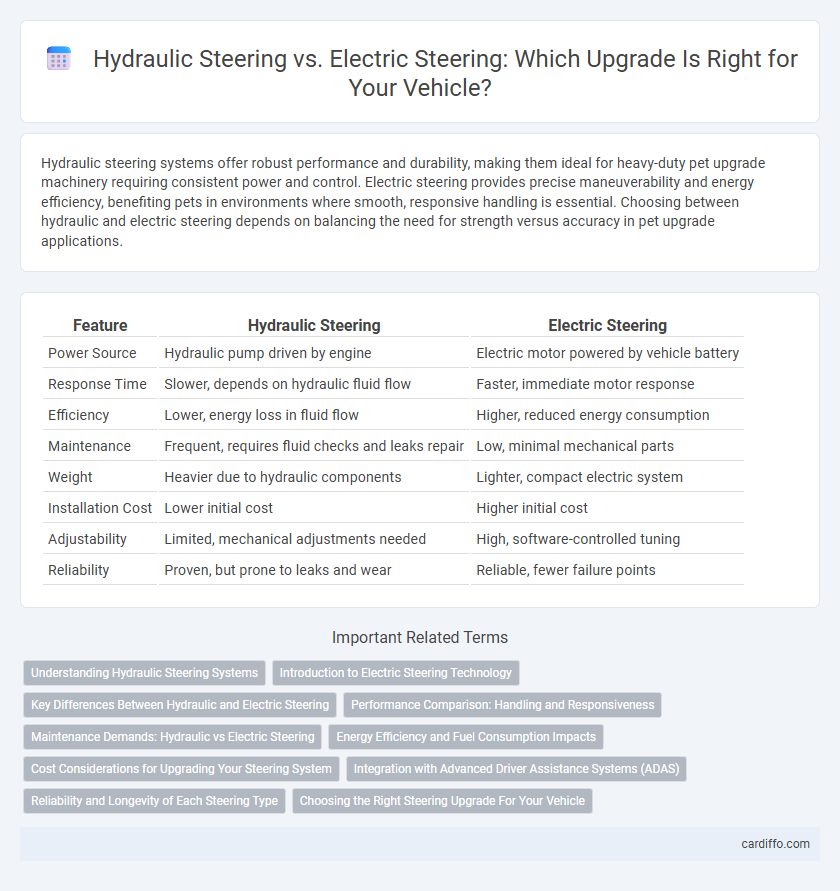Hydraulic steering systems offer robust performance and durability, making them ideal for heavy-duty pet upgrade machinery requiring consistent power and control. Electric steering provides precise maneuverability and energy efficiency, benefiting pets in environments where smooth, responsive handling is essential. Choosing between hydraulic and electric steering depends on balancing the need for strength versus accuracy in pet upgrade applications.
Table of Comparison
| Feature | Hydraulic Steering | Electric Steering |
|---|---|---|
| Power Source | Hydraulic pump driven by engine | Electric motor powered by vehicle battery |
| Response Time | Slower, depends on hydraulic fluid flow | Faster, immediate motor response |
| Efficiency | Lower, energy loss in fluid flow | Higher, reduced energy consumption |
| Maintenance | Frequent, requires fluid checks and leaks repair | Low, minimal mechanical parts |
| Weight | Heavier due to hydraulic components | Lighter, compact electric system |
| Installation Cost | Lower initial cost | Higher initial cost |
| Adjustability | Limited, mechanical adjustments needed | High, software-controlled tuning |
| Reliability | Proven, but prone to leaks and wear | Reliable, fewer failure points |
Understanding Hydraulic Steering Systems
Hydraulic steering systems use fluid pressure to assist wheel turning, providing smooth and powerful control in heavy-duty vehicles and machinery. These systems rely on a pump, typically driven by the engine, to circulate hydraulic fluid through hoses and a steering cylinder, converting driver input into mechanical movement. Understanding hydraulic steering is crucial for upgrades, as it offers durability and high torque but requires regular maintenance to prevent leaks and ensure system responsiveness.
Introduction to Electric Steering Technology
Electric steering technology uses electric motors and sensors to provide precise, responsive control with improved energy efficiency compared to traditional hydraulic steering systems. This system reduces maintenance requirements by eliminating hydraulic fluid, hoses, and pumps, while offering customizable steering assistance levels for enhanced driving comfort and safety. Advanced electric steering integrates seamlessly with driver-assistance features, supporting automated and semi-autonomous vehicle functions.
Key Differences Between Hydraulic and Electric Steering
Hydraulic steering systems rely on fluid pressure generated by a pump driven by the engine to assist steering, providing strong, consistent feedback and better performance at high speeds. Electric steering uses an electric motor controlled by sensors and a computer, offering improved fuel efficiency, lower maintenance, and easier integration with advanced driver-assistance systems (ADAS). Key differences include hydraulic steering's dependence on engine power and fluid maintenance versus electric steering's reliance on electrical components and software calibration.
Performance Comparison: Handling and Responsiveness
Hydraulic steering systems offer robust handling with smooth, consistent feedback under heavy loads, making them ideal for off-road and heavy-duty applications. Electric steering delivers superior responsiveness with precise control and quicker adjustment due to electric motor assistance, enhancing maneuverability, especially at low speeds. Performance-wise, electric steering systems tend to provide better adaptability and efficiency for modern vehicles, while hydraulic systems excel in environments requiring high steering force.
Maintenance Demands: Hydraulic vs Electric Steering
Hydraulic steering systems require regular maintenance, including fluid checks, hose inspections, and potential leak repairs, which can be time-consuming and costly. Electric steering systems have lower maintenance demands as they rely on electronic components rather than hydraulic fluid, reducing the risk of leaks and pump failures. Transitioning to electric steering can lead to decreased downtime and overall maintenance expenses.
Energy Efficiency and Fuel Consumption Impacts
Hydraulic steering systems consume more engine power due to the constant operation of the hydraulic pump, leading to increased fuel consumption and reduced energy efficiency. Electric steering systems utilize electric motors only when steering input is detected, significantly reducing energy usage and improving overall fuel economy. Studies show electric power steering can enhance fuel efficiency by up to 5%, decreasing greenhouse gas emissions compared to hydraulic counterparts.
Cost Considerations for Upgrading Your Steering System
Hydraulic steering systems generally have higher installation and maintenance costs due to the need for pumps, hoses, and fluid changes, whereas electric steering systems offer lower long-term expenses with reduced maintenance and energy consumption. Upgrading to electric steering can lead to significant cost savings by eliminating hydraulic fluid leaks and reducing the number of mechanical components requiring regular service. When budgeting for a steering upgrade, factor in not only initial equipment costs but also the potential for decreased maintenance fees and improved fuel efficiency with electric systems.
Integration with Advanced Driver Assistance Systems (ADAS)
Electric steering systems offer superior integration with Advanced Driver Assistance Systems (ADAS) due to their precise electronic control and seamless communication with vehicle sensors and actuators. Hydraulic steering lacks the ability to directly interface with ADAS components, limiting its effectiveness in features such as lane-keeping assist and automated parking. Enhanced data exchange in electric steering enables real-time adjustments and improved vehicle safety performance under complex driving conditions.
Reliability and Longevity of Each Steering Type
Hydraulic steering systems are renowned for their durability and robust performance, often lasting over 10,000 hours with regular maintenance due to their mechanically simple design and high-pressure fluid operation. Electric steering systems, while offering precise control and lower maintenance requirements, typically have a lifespan influenced by battery health and electronic component quality, averaging around 5 to 7 years depending on usage intensity. Choosing between hydraulic and electric steering involves weighing hydraulic's proven longevity against electric's technological advancements and lower operational complexity.
Choosing the Right Steering Upgrade For Your Vehicle
Hydraulic steering systems offer robust, reliable control with a tactile feel ideal for heavy-duty and off-road vehicles, providing consistent feedback and durability under high stress. Electric steering systems improve fuel efficiency and require less maintenance, delivering precise control with customizable assistance levels, making them suitable for modern passenger cars. Selecting the right steering upgrade depends on vehicle type, driving conditions, and desired performance, balancing the mechanical strength of hydraulics against the efficiency and adaptability of electric power steering.
Hydraulic Steering vs Electric Steering Infographic

 cardiffo.com
cardiffo.com